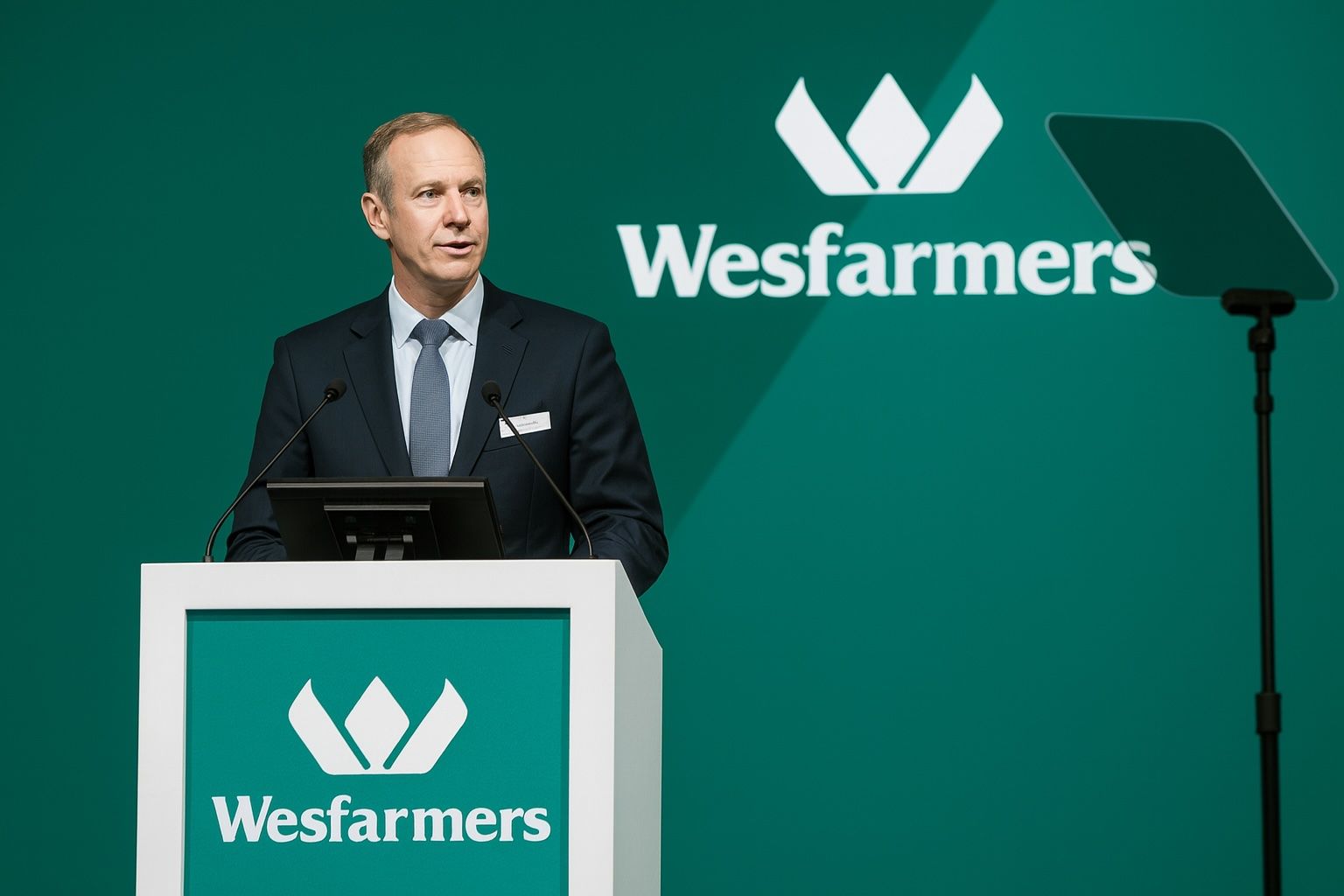Australia’s retail-conglomerate heavyweight Wesfarmers Limited (ASX: WES) heads into Monday’s session with a mix of record profits, a large capital return, fresh lithium momentum and a few growing regulatory and cost headwinds all jostling for investors’ attention.
Below is a pre‑open briefing on the key numbers, news and themes to have on your radar before trading resumes on Monday, 17 November 2025.
Key points
- Last close: Wesfarmers shares last traded at A$81.13, down 0.44% on Friday 14 November, according to the company’s own share‑price page. [1]
- Record FY25 result: FY25 revenue rose to A$45.7 billion and net profit after tax to A$2.93 billion, with profit excluding significant items up 3.8% year on year. [2]
- Big capital return loading: A A$1.50 per share distribution (A$1.10 capital return + A$0.40 fully‑franked special dividend) is locked in for 4 December 2025, with shares already trading ex‑entitlement since 5 November. [3]
- Dividend strength: On top of that, Wesfarmers is paying a fully‑franked FY25 ordinary dividend of A$2.06 per share (95c interim + A$1.11 final), up 4% on FY24. [4]
- Growth themes: The group is ramping up its Covalent Lithium joint venture (first battery‑grade lithium hydroxide produced at Kwinana in July 2025) and rolling out solar, batteries and EV chargers across Bunnings and Officeworks with the help of a A$100 million CEFC loan. [5]
- Macro backdrop: The RBA kept the cash rate at 3.60% in November after a surprise inflation jump to 3.2% y/y, while consumer sentiment has turned positive for the first time in almost four years, a crucial mix for a retail‑exposed name like Wesfarmers. [6]
- Watchpoints for Monday: Post‑distribution pricing, ongoing reaction to AGM commentary on cost pressures and tax proposals, sentiment on lithium and ESG issues, and how WES trades relative to the soft ASX 200 backdrop.
Wesfarmers share price snapshot before the 17 November open
Wesfarmers closed Friday, 14 November 2025 at A$81.13, down 0.44% on the day, after a volatile fortnight for the broader ASX. [7]
Over the past 12–18 months, the stock has:
- Traded in a broad mid‑A$60s to mid‑A$90s range, according to company and market‑data providers. [8]
- Delivered roughly 20–30% share‑price gains year‑to‑date 2025 (before adjusting for the new A$1.50 capital management payout), making it one of the stronger blue chips on the ASX 200. [9]
Valuation is rich:
- Simply Wall St recently highlighted a price‑to‑earnings ratio of about 35.6x, versus a large portion of Australian companies trading on sub‑21x multiples, and flagged this as a potential concern if growth slows. [10]
In other words, Wesfarmers is still priced as a high‑quality compounder, and part of Monday’s story will be whether investors remain comfortable paying that premium now that the ex‑dividend/ex‑capital‑return drop is in the rear‑view mirror.
Earnings backdrop: record FY25 profits and resilient retail
Wesfarmers’ FY25 numbers set the tone for how the stock is being priced going into this week:
- Revenue: A$45.7 billion, up 3.4% from FY24.
- EBIT (ex‑significant items): A$4.19 billion, up 4.9%.
- NPAT: A$2.93 billion, up 14.4%.
- NPAT (ex‑significant items): A$2.65 billion, up 3.8%. [11]
Key divisional highlights:
- Bunnings Group – Earnings before tax up about 3.8% to A$2.34 billion, driven by steady demand for home‑improvement and “necessity” products. [12]
- Kmart Group (Kmart + Target) – Earnings before tax up 9.2% to around A$1.1 billion, with strong transaction growth and the Anko private‑label brand resonating well even with higher‑income shoppers. [13]
- Officeworks – More modest earnings growth of about 1.9%, with management warning that elevated costs and competitive intensity will pressure FY26 profits by roughly A$15–25 million versus the prior year. [14]
- Wesfarmers Health – Revenue up 5.5%, profit up strongly off a lower base as Priceline Pharmacy and related health assets grow and integrate. [15]
- WesCEF (chemicals, energy & fertilisers) – Revenue up 7.8% with solid fertiliser and ammonium nitrate volumes, partly offset by softer global prices. [16]
At the 30 October 2025 AGM, CEO Rob Scott reiterated that:
- Group sales have started FY26 in positive shape, particularly at Bunnings and Kmart.
- However, cost pressures in labour, energy, domestic supply chains and regulation are still biting, and Officeworks margins will remain under pressure. [17]
This “solid but not cost‑free” profit story is crucial context for how WES trades into Monday: earnings are growing, but investors are increasingly alert to margin squeeze risks.
Capital management: A$1.50 per share on the way
The single most important near‑term event for Wesfarmers shareholders is the A$1.50 per share capital management initiative, now fully approved.
According to Wesfarmers’ capital‑management documents and ASX notices: [18]
- Shareholders will receive a total distribution of A$1.50 per share, split into:
- A$1.10 return of capital (Capital Component), and
- A$0.40 fully‑franked special dividend (Dividend Component).
- The record date for both components was 4:00pm (Perth time) on Thursday 6 November 2025.
- Wesfarmers shares started trading ex‑capital‑return and ex‑special dividend from Wednesday 5 November.
- Both components are scheduled to be paid on Thursday 4 December 2025, for a total cash outlay of about A$1.7 billion.
- The distribution is funded from asset‑sale proceeds, including:
- The remaining Coles stake,
- The sale of Coregas, and
- Divestment of WesCEF’s domestic LPG and LNG distribution businesses. [19]
Wesfarmers emphasises that:
- No shares will be cancelled; the return of capital reduces share capital but not share count.
- The board expects no material impact on credit ratings and believes the balance sheet will still support growth investments and acquisitions. [20]
Why this matters for Monday’s trade
Because WES is already trading ex‑entitlement, the headline share price is lower than pre‑November levels by roughly the amount of the distribution, which can make performance look worse than the underlying total‑return picture. Analysts and institutions will be watching how quickly the stock stabilises as short‑term dividend and capital‑return traders exit and longer‑term holders refocus on fundamentals.
Ordinary dividends: a growing income stream
On top of the special distribution, Wesfarmers remains a reliable dividend payer:
- Interim FY25 dividend: 95 cents per share, fully franked (record date 26 February 2025, paid 1 April 2025). [21]
- Final FY25 dividend: A$1.11 per share, fully franked (record date 3 September 2025, paid 7 October 2025). [22]
- Total ordinary dividend for FY25:A$2.06 per share, up 4% on FY24. [23]
Depending on which data provider and share price you use, Wesfarmers’ trailing dividend yield (excluding the A$1.50 capital initiative) sits somewhere in the 2.5–4.5% range, reflecting both the strong share‑price run and the substantial franked distributions. [24]
For income‑focused investors, the combination of a steadily rising ordinary dividend and the December capital return/special dividend is a key part of the bull case that will be in focus again on Monday’s open. [25]
Operations and growth: from hardware and Kmart to lithium and health
Core retail & health engines
Wesfarmers’ diversified portfolio remains dominated by retail and health: Bunnings, Kmart Group, Officeworks, Wesfarmers Health and its digital assets. [26]
Recent results emphasise:
- Bunnings: Still the group’s profit powerhouse, benefiting from strong demand for repair, maintenance and trade products. Management highlights ongoing cost discipline and productivity initiatives to preserve margins while keeping prices sharp. [27]
- Kmart & Target: Efficient operations and the in‑house Anko brand are driving both volume and mix improvements. Anko is now gaining traction with higher‑income households, suggesting Wesfarmers is successfully stretching the value proposition up‑market. [28]
- Wesfarmers Health (including Priceline Pharmacy and digital health assets like InstantScripts and SILK): Earnings are growing rapidly as the portfolio scales and integrates. Health is now a meaningful third growth pillar alongside hardware and discount retail. [29]
Covalent Lithium: first product and a long ramp ahead
Wesfarmers owns 50% of Covalent Lithium alongside Chile’s SQM. The joint venture’s integrated project combines the Mt Holland mine with a lithium hydroxide refinery at Kwinana, WA. [30]
Key milestones so far:
- Covalent confirmed it produced its first battery‑grade lithium hydroxide in July 2025 at Kwinana. [31]
- The refinery is designed for around 50,000 tonnes per year at full capacity. [32]
- A serious bushfire near Mt Holland in January 2025 temporarily threatened operations, but Covalent reports that all personnel remained safe and critical infrastructure was undamaged, with the mine now back to normal operations. [33]
- Wesfarmers’ AGM commentary calls FY26 a “transitional year” for Covalent, with production expected to ramp up over the next ~18 months. [34]
Lithium prices have cooled from their 2021–22 peaks and other WA refineries have had well‑publicised commissioning issues, but Covalent’s smooth first‑product milestone has been noted positively against that backdrop. [35]
For Monday’s trade, the lithium story is less about immediate earnings (Covalent is still ramping) and more about whether investors see this as a value‑accretive long‑term option or a source of added execution risk.
Decarbonisation and the A$100m CEFC loan
Sustainability is increasingly central to the Wesfarmers investment narrative:
- In mid‑2025, the Clean Energy Finance Corporation (CEFC) agreed a A$100 million loan with Wesfarmers to fund solar panels, battery storage and EV chargers across Bunnings and Officeworks stores. [36]
- The initiative supports Wesfarmers’ goals of 100% renewable electricity by end‑2025 and net‑zero direct (Scope 1 & 2) emissions by 2030, while also cutting energy costs and adding resilience to the grid. [37]
Investors with an ESG lens will likely keep this programme in mind on Monday, particularly given the group’s simultaneous privacy and retail‑crime‑related controversies (more on those below).
Recent news flow: tax, crime, privacy and online competition
Several non‑financial headlines have also shaped sentiment ahead of 17 November.
Cost pressures and tax debate
At the 2025 AGM, Wesfarmers’ chair Michael Chaney and CEO Rob Scott used strong language about:
- Escalating operating costs – especially energy, wages, logistics and compliance. [38]
- A Productivity Commission proposal for a 5% “cash‑flow tax” on large businesses, which Chaney argued would deter investment and damage Australia’s competitiveness. [39]
Wesfarmers shares dropped sharply (around 5–7%) on 30 October as these concerns coincided with a broader risk‑off day on the ASX. [40]
This tax and cost narrative is likely to remain in investors’ minds on Monday, especially as markets debate how long elevated inflation might keep pressure on corporate margins.
Retail crime and store‑level safety
At the same AGM, Wesfarmers revealed:
- A sharp rise in threats and assaults against staff at Bunnings, Kmart and other chains, with threatening incidents reportedly up 29% at Kmart and 66% at Bunnings over key periods, and Victoria singled out as a hotspot. [41]
The company is pushing for tougher legal protections and increased enforcement. For shareholders, the concern is twofold:
- Higher security and shrinkage costs impacting margins.
- Reputational and employee‑relations risk if customers perceive stores as unsafe or over‑policed.
Privacy rulings on facial recognition
In September, Australia’s privacy regulator found that Kmart, owned by Wesfarmers, breached privacy law by using facial‑recognition technology in 28 stores without adequate notice or consent. [42]
The determination:
- Adds to a previous ruling that Bunnings misused facial recognition. [43]
- Raises ESG and regulatory‑risk questions, even as management argues such technologies are needed to tackle increasing retail crime.
While not a direct earnings hit (yet), the case will be part of the longer‑term risk assessment that institutional investors carry into Monday’s session.
Pressure from ultra‑cheap online rivals
Wesfarmers CEO Rob Scott has also joined other retail leaders in warning about competition from Temu and Shein, arguing these platforms exploit tax and regulatory loopholes and contribute to environmental and social harms. [44]
This matters for Wesfarmers because:
- It underscores the structural pressure on margins in categories like apparel and general merchandise.
- It reinforces the strategic importance of Wesfarmers’ own digital ecosystem (OnePass, online marketplaces and retail‑media network) as it tries to keep customers in its ecosystem. [45]
Macro backdrop: rates on hold, inflation sticky, sentiment improving
The Australian macro environment heading into Monday is mixed but slowly turning more supportive for large retailers:
- The RBA left the cash rate at 3.60% at its 4 November 2025 meeting, after three cuts earlier in the year. The Board signalled caution following a stronger‑than‑expected September‑quarter CPI reading (headline 3.2% y/y, 1.3% q/q; trimmed mean around 3%). [46]
- Despite that inflation surprise, consumer sentiment jumped to 103.8 in November, the first reading above 100 in almost four years, suggesting more households are optimistic than pessimistic about the outlook. [47]
- The ASX 200 has been drifting lower in recent sessions on revived rate‑hike worries and global growth concerns, with defensives and quality names sometimes outperforming. [48]
For Wesfarmers, this cocktail means:
- Short‑term sales may benefit from rising confidence and real incomes stabilising.
- But valuation multiples are vulnerable if bond yields back up or if inflation stays at the top of the RBA’s target band for longer than expected.
Valuation and sentiment: quality priced for perfection?
Beyond the raw numbers, a lot of recent commentary has focused on how much good news is already in the WES share price.
- Simply Wall St flagged the ~35.6x P/E multiple as “lofty” relative to the broader Australian market, noting that analyst consensus is for only mid‑single‑digit annual EPS growth over the next three years. [49]
- Several investor‑oriented publications have praised Wesfarmers as a “retiree’s dream” or “buy‑and‑hold blue chip” thanks to its dividend history and diversified profit streams, while also cautioning that the stock may be expensive after a huge multi‑year run. [50]
- Technical analysis sites currently rate the stock as short‑term weak/overbought‑then‑oversold, pointing to recent volatility and a negative near‑term signal even as fundamentals look strong. [51]
Heading into Monday, the bull case remains that Wesfarmers is a high‑quality compounder with:
- Strong brands (Bunnings, Kmart, Officeworks, Priceline),
- Exposure to structural growth in healthcare and energy transition (Covalent Lithium, decarbonisation capex), and
- A track record of disciplined capital allocation and cash returns.
The bear case is that valuation assumes a lot, and any stumble in retail demand, lithium ramp‑up, regulatory outcomes or cost control could lead to a de‑rating.
What to watch when the ASX opens on Monday, 17 November 2025
Here are the main things traders and long‑term investors are likely to focus on as WES starts the new week:
1. Price action vs. the broader ASX 200
- Does Wesfarmers trade in line with or better than the index after a choppy, rate‑sensitive fortnight?
- Do buyers step in now that the stock is clearly ex‑dividend and ex‑capital‑return, or does distribution‑related selling continue?
2. Ongoing digestion of AGM messaging
Investors may still be repositioning after the 30 October AGM:
- Watch for any follow‑through from negative reactions to comments on labour, energy and regulatory costs, plus the mooted 5% cash‑flow tax. [52]
- Check whether analysts or broker notes published since the AGM have led to price‑target changes or rating revisions.
3. Lithium and energy‑transition sentiment
Even though Covalent is not yet a major earnings contributor, any:
- Lithium‑price moves or updates on WA refining projects generally, or
- News around Covalent’s ramp‑up or offtake agreements,
could colour how the market values Wesfarmers’ long‑dated growth optionality.
4. Retail health and macro data
With consumer confidence finally nudging higher and rates on hold, investors will be:
- Watching retail sales data, job numbers and inflation expectations for signs that household spending can sustain Wesfarmers’ FY25 momentum. [53]
Any new macro headlines over the weekend (particularly from the US or China) could also shift risk appetite for cyclical retailers on Monday morning.
5. ESG and regulatory developments
Potential catalysts over the coming days and weeks include:
- Follow‑up actions or appeals related to the Kmart facial‑recognition ruling, with investors watching for fines, remediation costs or operational changes. [54]
- Public or political response to Wesfarmers’ calls for tougher retail‑crime laws and a rethink of tax settings that favour ultra‑cheap cross‑border e‑commerce. [55]
Bottom line
Heading into the 17 November 2025 open, Wesfarmers sits at the crossroads of several major themes on the ASX:
- It is a defensive‑leaning, high‑quality retailer on premium multiples,
- Returning A$1.7 billion to shareholders via a mix of capital return and special dividend,
- Leveraging strong core brands while pushing into health and battery materials, and
- Navigating sticky inflation, evolving regulation, higher retail crime and intense online competition.
Whether WES continues to justify its valuation from here will depend less on the already‑announced capital return and more on its ability to:
- Protect margins in a still‑inflationary environment,
- Deliver a smooth Covalent Lithium ramp‑up, and
- Keep growing dividends without compromising balance‑sheet strength.
For now, the stock remains one of the most closely watched names on the ASX 200, and Monday’s session will offer another important read on how much optimism the market is willing to price into Wesfarmers heading into 2026.
Important: This article is general information only and is not financial advice or a recommendation to buy or sell Wesfarmers shares. Always consider your objectives, financial situation and needs, and seek professional advice before making investment decisions.
References
1. www.wesfarmers.com.au, 2. www.wesfarmers.com.au, 3. www.wesfarmers.com.au, 4. www.wesfarmers.com.au, 5. www.covalentlithium.com, 6. www.rba.gov.au, 7. www.wesfarmers.com.au, 8. www.wesfarmers.com.au, 9. www.intelligentinvestor.com.au, 10. simplywall.st, 11. www.wesfarmers.com.au, 12. www.wesfarmers.com.au, 13. www.wesfarmers.com.au, 14. www.wesfarmers.com.au, 15. www.wesfarmers.com.au, 16. www.wesfarmers.com.au, 17. www.news.com.au, 18. www.wesfarmers.com.au, 19. www.wesfarmers.com.au, 20. www.wesfarmers.com.au, 21. www.wesfarmers.com.au, 22. www.wesfarmers.com.au, 23. www.wesfarmers.com.au, 24. tradingeconomics.com, 25. finance.yahoo.com, 26. www.wesfarmers.com.au, 27. www.wesfarmers.com.au, 28. www.wesfarmers.com.au, 29. www.wesfarmers.com.au, 30. australianminingreview.com.au, 31. www.covalentlithium.com, 32. www.argusmedia.com, 33. www.covalentlithium.com, 34. announcements.asx.com.au, 35. www.miningmagazine.com, 36. www.theguardian.com, 37. www.theguardian.com, 38. www.news.com.au, 39. www.capitalbrief.com, 40. www.capitalbrief.com, 41. www.couriermail.com.au, 42. www.reuters.com, 43. www.reuters.com, 44. www.theaustralian.com.au, 45. www.wesfarmers.com.au, 46. www.rba.gov.au, 47. www.reuters.com, 48. www.abc.net.au, 49. simplywall.st, 50. www.fool.com.au, 51. stockinvest.us, 52. www.news.com.au, 53. www.reuters.com, 54. www.reuters.com, 55. www.couriermail.com.au







